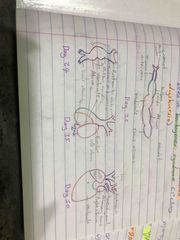![]()
![]()
![]()
Use LEFT and RIGHT arrow keys to navigate between flashcards;
Use UP and DOWN arrow keys to flip the card;
H to show hint;
A reads text to speech;
14 Cards in this Set
- Front
- Back
- 3rd side (hint)
|
Heart Morphogenis |
1- First functional organ in vertebra 2- beats spontaneously by 4 weeks |
|
|
|
Cardiac looping |
1 Peimary heart loops to establish left right polarity ( 4 weeks) 2- Defects in left right dynein (L/R asymmetry) can lead to dextracardia seen in kartogener syndrome (primary ciliary dyskinesia) |
|
|
|
Days of heart looping |

Day 22- aortic root- truncus arteriosus- bulbous cordis- ventricule- atrium - sinus venous Day 24- Day 35- Day 50- |
|
|
|
Septation of the chambers Atria |

1- Septum primum grows towards the endocardial cushion narrowing foremen primum 2- Foramen secundum form septum premium 3- Septum secundum develops on the right side of septum primum (foramen primum maintain right to left shunt) 4- septum secundum expand and covers most of Foramen secundum forming Foramen ovale 5- septum primum forms a one way valve of Foramen ovale 6- septum primum closed against septum secundum sealing Foramen ovale soon after birth (increase LA pressure decrease RA pressure ) 7- septum primum fuses with septum secundum during infancy/early childhood to form atrial septum |
|
|
|
Separation of the chamber Ventricles |
1- muscular interventricular septum (interventricular Foramen) 2- Aorticopulmonary septum fuses with muscular interventricular septum to form membranous interventricular Foramen closing interventricular Foramen 3- growth of endocardial cushion - separate atria from ventricle Contributes to atrial separation and membranous interventricular septum |
|
|
|
Outflow tract formation |
Neural crest and endocardial crest migrate 1- Truncal and bulbar ridge spiral and fuse to form aorticopulmonay septum 2- Ascending aorta and pulmonary trunk |
|
|
|
Failure of neural cell migration 3 Ts |
1- Transposition of great arteries 2- Tetralogy of Fallot 3- Persistent truncus arteriosus |
|
|
|
Patent Foramen ovale |
1- failure of fusion of the septum primum and septum secundum 2- most left untreated 3- leads to paradoxical emboli Can occur in ASD |
|
|
|
Valve development |
AV valves- endocardial cushion of the outflow tract Mitral/tricuspid- endocardial cushion of the AV canal |
|
|
|
Heart embryology develop in what structure |
1- Truncus arteriosus- ascending aorta and pulmonary trunk 2- Bulbus Codis- smooth part of left and right ventricle 3- Primitive ventricle- trabeculated part of left and right ventricle 4- Primitive atrium- trabeculated part of left and right atrium 5- left horm of sinus venous- coronary sinus 6- Right horn of sinus venosus- smooth part of right atrium 7- Endocardial cushion 1- atrial septum 2- AV valve and semilunar valve 3- membranous interventricular septum 8- Right common and anterior cardinal vein- SVC 9- Posterior sub cardinal and Supra cardinal vein- IVA 10- Primitive pulmonary trunk- smooth left atrium |
|
|
|
Fetal circulation |
Umbilical vein 80% saturated with oxygen Oxygenated blood umbilical vein 2- Ductus arteriosus (bypass hepatic circulation) 3- IVC 4- right atrium 5- Foramen ovale 6- left atrium Deoxygenated blood- 1- SVA 2- RA 3- RV 4- main pulmonary artery 5- ductus arteriosus 6- descending aorta |
|
|
|
Closure of ductus arteriosus |
1- Infant takes first breath 2- decrease resistance in pulmonary vasculature 3-Increase pressure in LA, decrease pressure in RA 4- increase oxygen 5- decrease prostaglandin from placenta |
|
|
|
Use of indomethacin |
Prostaglandin E1 and E2 KEEP PDA open Indomethacin helps close PDA - liagmentum arteriosus |
Come in and close the door |
|
|
Fetal postnatal derivative |
1- Ductus arteriosus- ligamentum arteriosum Near left recurrent laryngeal nerve 2- Ductus venosus- ligamentum venosum 3- Foramen ovale- fossa ovalis 4- Allantois- Urachus(bladder and umbilicus)- median umbilical ligament 5- umbilical artery- medial umbilical ligament 6- umbilical vein- ligamentum teres hepatis (round ligament) Contain falciform ligament 7- Notochord- nucleus pulposus |
|

